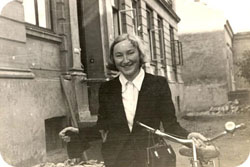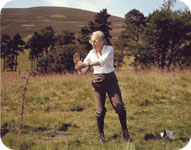The Woman

Gerda with her mother
in 1921
Gerda 'Pytt' Geddes (1917-2006), who was known to most people by her nickname Pytt, led an intriguing and multi-layered life underpinned by three important strands: psychology, dance and tai chi.
She was born in Bergen, Norway. Her father was a prominent and successful businessman and politician who served in the Norwegian Government and socialised with royalty (Gerda relished the tale of the night she was sung lullabies by Queen Maud of Norway). He intended his daughter to have a 'proper' education and take her place in society as wife, mother and head of a household. She had other plans, however, and immersed herself in the bohemian world of pre-war Oslo where she associated with all manner of creative people including dancers, painters, and the coterie that surrounded Wilhem Reich, the famous, sometimes infamous, psychoanalyst and psychosexual pioneer. She enrolled at dance school, studied psychology at the University of Oslo, and began psychoanalysis with one of Reich's protégés, Dr Ola Raknes.

Occupied Oslo 1941.
She joined the Resistance the following year
The independence and creativity that went with her lifestyle made it inevitable that she would rebel against the Nazi occupation of Norway. She joined the Resistance, narrowly evaded capture, and lived for weeks in safe houses and cellars before eventually making a perilous escape to Sweden, smuggled out with five other adults and three children hidden under a lorry-load of timber.
During her two-year exile in Stockholm she continued her training in dance and psychoanalysis and, when the war ended, used these skills to devise dance therapy for traumatised concentration camp victims.
By the time Gerda met her future husband, David Campbell Geddes, she was working as a movement instructor with the Norwegian National Theatre. Her job was to help actors to make full use of their bodies, and to explore how the physical and the psychological combined to create character.
Soon after the couple married in 1948, David found a job in China and they moved to Shanghai. It was during a dawn walk with her husband that Gerda first encountered the mysterious ritual of tai chi. What she witnessed that morning beside a paddy field had a life-changing impact upon her.
“As we turned a corner where there was a bend in the canal, we saw an old Chinese man by the water. Beside him, in a gilded cage, was a mynah bird. The man was moving very slowly, performing some incredibly beautiful dance-like movements which were reflected in the water of the canal. He seemed so totally absorbed in what he was doing that he paid not the slightest attention to us. We just stood there watching, quite mesmerised. I remember thinking: ‘This is what I have been looking for all my life.’” Gerda 'Pytt' Geddes.

Gerda Practising outside her
Hong Kong home in 1957
She determined to find out more and to find someone who could teach her this sequence of strange movements. Unknown to her and her husband, a cruel twist awaited them. They had come to a country where a civil war, which had rumbled on for decades, was reaching a climax. Within a few weeks of their arrival in Shanghai, the city fell to Mao Tse-tung's People's Liberation Army, and the freewheeling boomtown known as the Paris of the Orient and the Whore of Asia quickly changed. Bribery, corruption, blackmarketeering and prostitution disappeared almost overnight. Westerners, especially members of the business community, could not leave and for the next two years Gerda and her family were effectively hostages there.
Eventually they were allowed to go to Hong Kong where Gerda managed to persuade a Chinese tai chi master to do the unthinkable and teach a western woman.
She became the first European to bring tai chi to Britain when the family left the Far East for good in 1958. She gave the first demonstration on British television in 1959. Then in the 1960s she began to share her knowledge by teaching dancers in London, contemplative monks in Sussex, academics in Cambridge, and an intriguing mixture of artists, writers, doctors, dope-smoking hippies, and the simply curious who turned up at her classes. For almost thirty years she taught tai chi classes at The Place, the home of the London Contemporary Dance School, and her work there with dancers is acknowledged as having influenced the development of contemporary dance.
In 1991 she wrote Looking for the Golden Needle which outlined her belief that the symbolism of tai chi contained an archetypal blueprint of human life. She called it the Allegorical Journey and it directed not just her teaching but the way she lived her life.

Gerda aged 82 practising tai chi
on a Scottish mountainside
(photo: Claes Svanteson)
There was however nothing precious or otherworldly about Gerda Geddes. She was a practical and direct Norsewoman, a consummate needle-worker and dressmaker who prized elegance and the finer things in life, a straight talker who debunked any attempt to clothe her in the mantle of master or guru. She was passionate about dance, theatre and music and was a friend of Benjamin Britten and Peter Pears. She was a regular guest of her sister-in-law Princess Margaret of Hesse and the Rhine, whose German home, Schloss Wolfsgarten, played host to many artists, writers and musicians.
After Gerda’s death in 2006, a Celebration of her life, held at The Place in London, included dance pieces specially choreographed by her former tai chi pupil Richard Alston. As Frank Woods writes in Dancer in the Light, one of the dance pieces had special poignancy:
“Two dresses survived an affair Gerda had in 1940 with a strikingly handsome dancer who also designed clothes for her – some to wear and some to dance in. A simple black one was worn by a slim, blonde dancer who performed a hypnotic dance incorporating tai chi inspired movements: for a few breathtaking moments a young Gerda from avant-garde Oslo was dancing again.”
top

